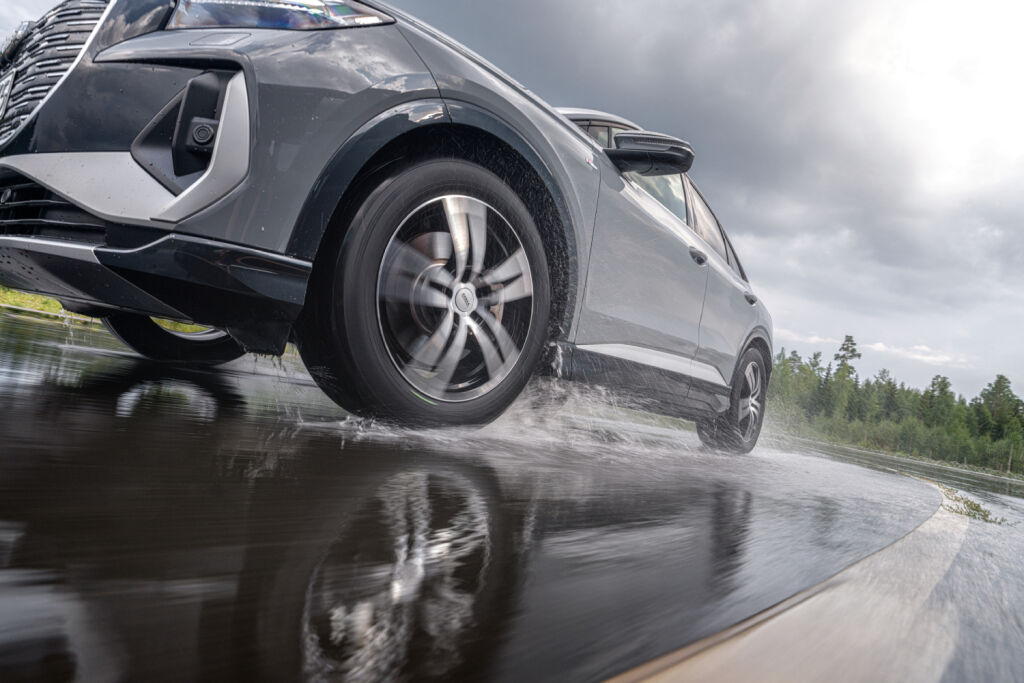
Good tires and staying alert in traffic reduce your stopping distance if you need to slam on the brakes.
To find out your car's stopping distance, you need to know the thinking and braking distances, which are affected by many factors. Poor weather, driving conditions, vehicle speed, and the driver’s alertness play a large role, but so do the tires. Ensure your car is equipped with premium tires for the weather, and check their condition before heading on the road.
Thinking distance and reaction time
Before properly defining stopping or braking distance, let’s look at what happens before the driver starts braking. This is where the concepts of thinking distance and reaction time come into play.
Thinking distance refers to the distance the vehicle travels from the moment a driver notices a hazard on the road and decides on their next course of action. Meanwhile, reaction time refers to the time it takes to perceive the danger and react. All of this occurs before the driver pushes the brake pedal.
Under optimal conditions, the driver’s reaction time is around one second but can be much longer due to distractions, old age and intoxication, for instance.
Braking distance and stopping distance
You need to know both the thinking and braking distance to deduct the overall stopping distance. When speaking of the car’s braking distance, we refer to the distance a vehicle travels from the moment the driver applies the brakes until the car comes to a complete stop.
The overall stopping distance covers the whole distance the car travels from the moment the driver detects a hazard that requires braking to the point where the vehicle has come to a halt.
In this example, the velocity is 80 km/h (50 mph), and road conditions are good.
- The driver sees an obstacle on the road. During the time it takes the driver to react, the car travels 24 meters (79 feet).
- The driver hit the brakes. After applying the brakes, the car travels an additional 26 meters (85 feet).
- The vehicle stops. Overall, the stopping distance is approximately 50 meters (164 feet) in total.
At 100 km/h (62 mph), it takes 70 meters (230 feet) to stop.
Which factors affect braking and stopping distance
Many factors influence the total stopping distance of your vehicle when you slam on the brakes.
- Substances like drugs and alcohol affect the driver’s reaction time, but so do tiredness and distractions, such as using a smartphone while driving.
- Poor driving conditions and low visibility due to fog, rain or snow can also impair the driver’s ability to perceive potential threats on the road.
- The faster the vehicle travels, the longer it takes to stop once the brakes have been applied. The braking distance is directly proportional to the square of the speed, which means that when speed doubles, the braking distance grows four-fold.
- Problems and defects in your vehicle’s braking system lead to accidents in case of sudden braking. Regular checks and maintenance help ensure the brake pads, rotors, and brake fluid are ready for the road.
- Wet and icy road surfaces reduce the braking performance of tires. Therefore, you should always keep enough distance from the car in front of you, especially in difficult weather.
One way to reduce braking and stopping distance is by ensuring your tires are always in top shape. Check your tire tread and air pressure regularly, and choose the right type of tire for the weather. Visit your local Nokian Tyres dealer to find premium tires for your vehicle.
Please remember that it is the driver’s responsibility to ensure their tires are safe and suitable for their vehicle and to follow the vehicle’s manufacturer´s guidelines for proper use and maintenance. Consult your closest Nokian Tyres dealer or your vehicle’s manufacturer for specific advice.


